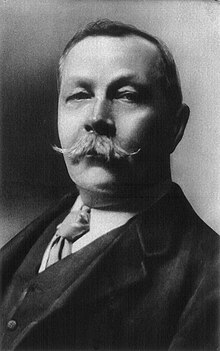About the Book: "The Adventure of the Resident Patient", one of the 56 Sherlock Holmes short stories written by British author Sir Arthur Conan Doyle, is one of 12 stories in the cycle collected as The Memoirs of Sherlock Holmes. Doyle ranked "The Adventure of the Resident Patient" eighteenth in a list of his nineteen favourite Sherlock Holmes stories.
About the Author: Arthur Ignatius Conan Doyle was born on 22 May 1859 at 11 Picardy Place, Edinburgh, Scotland. From 1876 to 1881, he studied medicine at the University of Edinburgh, including a period working in the town of Aston (now a district of Birmingham) and in Sheffield, as well as in Shropshire at Ruyton-XI-Towns. While studying, Doyle began writing short stories. His earliest extant fiction, "The Haunted Grange of Goresthorpe", was unsuccessfully submitted to Blackwood's Magazine. His first published piece "The Mystery of Sasassa Valley", a story set in South Africa, was printed in Chambers's Edinburgh Journal on 6 September 1879. On 20 September 1879, he published his first non-fiction article, "Gelsemium as a Poison" in the British Medical Journal. In 1882 he joined former classmate George Turnavine Budd as his partner at a medical practice in Plymouth, but their relationship proved difficult, and Doyle soon left to set up an independent practice. Arriving in Portsmouth in June of that year with less than £10 (£900 today) to his name, he set up a medical practice at 1 Bush Villas in Elm Grove, Southsea. The practice was initially not very successful. While waiting for patients, Doyle again began writing stories and composed his first novels, The Mystery of Cloomber, not published until 1888, and the unfinished Narrative of John Smith, which would go unpublished until 2011. He amassed a portfolio of short stories including "The Captain of the Pole-Star" and "J. Habakuk Jephson's Statement", both inspired by Doyle's time at sea, the latter of which popularized the mystery of the Mary Celeste and added fictional details such as the perfect condition of the ship (which had actually taken on water by the time it was discovered) and its boats remaining on board (the one boat was in fact missing) that have come to dominate popular accounts of the incident. Doyle struggled to find a publisher for his work. His first significant piece, A Study in Scarlet, was taken by Ward Lock Co. on 20 November 1886, giving Doyle £25 for all rights to the story. The piece appeared later that year in the Beeton's Christmas Annual and received good reviews in The Scotsman and the Glasgow Herald. The story featured the first appearance of Watson and Sherlock Holmes, partially modeled after his former university teacher Joseph Bell. Doyle wrote to him, "It is most certainly to you that I owe Sherlock Holmes ... Round the center of deduction and inference and observation which I have heard you inculcate I have tried to build up a man." Robert Louis Stevenson was able, even in faraway Samoa, to recognize the strong similarity between Joseph Bell and Sherlock Holmes: "My compliments on your very ingenious and very interesting adventures of Sherlock Holmes. ... Can this be my old friend Joe Bell?" Other authors sometimes suggest additional influences—for instance, the famous Edgar Allan Poe character C. Auguste Dupin. A sequel to A Study in Scarlet was commissioned and The Sign of the Four appeared in Lippincott's Magazine in February 1890, under agreement with the Ward Lock company. Doyle felt grievously exploited by Ward Lock as an author new to the publishing world and he left them. Short stories featuring Sherlock Holmes were published in the Strand Magazine. Doyle first began to write for the 'Strand' from his home at 2 Upper Wimpole Street, now marked by a memorial plaque. In this period, however, Holmes was not his sole subject and in 1893, he collaborated with J.M. Barrie on the libretto of Jane Annie. Doyle was found clutching his chest in the hall of Windlesham Manor, his house in Crowborough, East Sussex, on 7 July 1930. He died of a heart attack at the age of 71. His last words were directed toward his wife: "You are wonderful." At the time of his death, there was some controversy concerning his burial place, as he was avowedly not a Christian, considering himself a Spiritualist. He was first buried on 11 July 1930 in Windlesham rose garden. He was later reinterred together with his wife in Minstead churchyard in the New Forest, Hampshire. Carved wooden tablets to his memory and to the memory of his wife are held privately and are inaccessible to the public. That inscription reads, "Blade straight / Steel true / Arthur Conan Doyle / Born May 22nd 1859 / Passed On 7th July 1930." The epitaph on his gravestone in the churchyard reads, in part: "Steel true/Blade straight/Arthur Conan Doyle/Knight/Patriot, Physician, and man of letters". Undershaw, the home near Hindhead, Haslemere, south of London, that Doyle had built and lived in between October 1897 and September 1907, was a hotel and restaurant from 1924 until 2004. It was then bought by a developer and stood empty while conservationists and Doyle fans fought to preserve it. In 2012 the High Court ruled that the redevelopment permission be quashed because proper procedure had not been followed. A statue honours Doyle at Crowborough Cross in Crowborough, where he lived for 23 years. There is also a statue of Sherlock Holmes in Picardy Place, Edinburgh, close to the house where Doyle was born.
My Review: In this story, Doctor Percy Trevelyan brings Holmes an unusual problem. Having been a brilliant student but a poor man, Dr. Trevelyan has found himself a participant in an unusual business arrangement. A man named Blessington, claiming to have some money to invest, has set Dr. Trevelyan up in premises with a prestigious address and paid all his expenses. In return, he demands three-fourths of all the money that the doctor’s practice earns, which he collects every evening, going over the books thoroughly and leaving the doctor five shillings and threepence (5/3d) of every guinea (21 shillings or 1 pound/1 shilling in pre-decimalized currency) from the day’s takings. Blessington is himself infirm, it turns out, and likes this arrangement because he can always have a doctor nearby.
Everything has gone fairly well for the doctor since the arrangement began. Now, however, something has happened to Mr. Blessington. He has become excitable and agitated, this after he said that he had read about a burglary somewhere in the city.
Shortly thereafter, the doctor acquired a new patient, a Russian nobleman with cataleptic fits. His grown son brought him in the evening while Mr. Blessington was taking his usual walk. The son insisted on waiting out in the waiting room while the doctor saw his father. During the consultation, the patient had a fit, sitting bolt upright and going quite rigid. The doctor rushed for some nitrite of amyl for his patient to inhale, but upon returning, found that both his patient and his son had left.
Surprisingly, the same two men came back the next evening, the son claiming that he had seen his father walk out into the waiting room and assumed the consultation was over. He then had taken his father home, only later realizing that something was not quite right. The doctor had another consultation with the Russian gentleman, and after they had left, Mr. Blessington was utterly beside himself. Someone had been in his room. There were footprints to prove it. It could only have been the Russian nobleman’s son, but why did he go in there? Nothing had been disturbed or stolen.
At this point in Dr. Trevelyan’s story, Holmes thinks that it would be wise to go to the doctor’s Brook Street practice right away to see for himself what this odd case is all about. He discovers firsthand just how paranoid Blessington has become: he greets Holmes, Watson, and Trevelyan with a gun, but the doctor convinces him that the visitors mean no harm.
Holmes asks Blessington who these men are, and why they want to molest him. Blessington nervously says that he cannot answer the first question, but by way of answering the second question, he says that he keeps all his money in a box in his bedroom, as he does not trust bankers. Holmes knows that it must be more than this. He leaves in disgust advising Blessington that he can expect no advice if he tries to deceive him.
Shortly after leaving, Holmes outlines to Watson his train of thought. He knows that two men, perhaps more, are out to get Blessington. The catalepsy was faked, just to keep Doctor Trevelyan busy so that he would not notice the other man going into Blessington’s room. They did not wish to steal anything, as can be seen in their failure to rummage around in the room. They chose an appointment in the evening knowing that there would be no other patients in the waiting room. Holmes also knows just looking at Blessington that he is afraid for his own life, and deduces that he must therefore know who is after him, for no man could have such enemies without knowing about it. Also, it was only by chance that Blessington was not in both times that these two men came; they were obviously not familiar with Blessington's personal habits.
The next morning brings news that Mr. Blessington has hanged himself. Dr. Trevelyan’s brougham is sent to 221B Baker Street to bring Holmes to the scene. When Holmes and Watson arrive, Blessington is still hanging there from a hook in his bedroom ceiling. Inspector Lanner is there. He believes that it is a suicide, but Holmes soon deduces otherwise. The cigar ends and other clues tell him that three other men were there, and for a while. They were let into the premises by a confederate inside, as the door was still barred in the morning. Suspicion falls on the new page, who has vanished.
It seems obvious to Holmes that the men came to “try” Blessington, and reached a verdict of guilty, and a sentence of death, which they then proceeded to carry out.
A little digging at police headquarters brings up the rest of the truth. All four of the men were once members of a criminal gang that robbed banks. Blessington’s real name was Sutton, and the other three, two of whom played the Russians, were Biddle, Hayward, and Moffat. After robbing the Worthington Bank of 7,000 pounds in 1875, Blessington (or Sutton) had turned informer, and as a result, another gang member, Cartwright, had been hanged for murdering the caretaker, and the other three had each been given 15 years in prison. Blessington’s “paranoia” was indeed a very real fear, caused by news of their early release, not by some burglary, as he claimed. The murderers chose hanging as their form of execution to avenge Cartwright.
Eventually, the page turns up, but the case against him falls apart for lack of evidence. As for the other three, they are never heard from again, and it is believed that they perished in the wreck of the Norah Creina off Portugal.



No comments:
Post a Comment